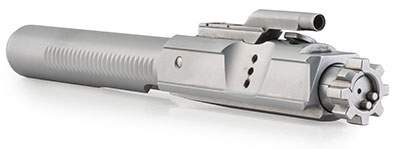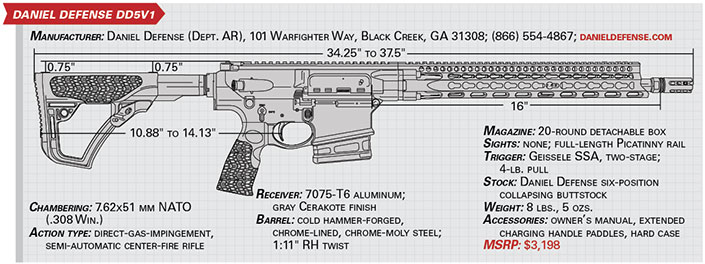
Among the many firms that produce AR-pattern rifles, some merely assemble parts and put their logos on the box, while others actually manufacture the firearms that wear their names. Daniel Defense is an example of the latter, and the Savannah, Ga.-based company has emerged as one of the leading AR manufacturers in the world. In 2015, the company introduced the DD5V1, the subject of this review, which marked Daniel Defense’s first foray into the 7.62x51 mm NATO rifle market.

Some readers may not realize that the original AR design (Eugene Stoner’s ArmaLite AR-10) was actually chambered for 7.62 mm NATO rather than 5.56x45 mm NATO. That said, in building the DD5V1, Daniel Defense did not simply copy existing 7.62 mm NATO variants or scale-up one of its 5.56 mm NATO rifles; the company took a fresh look at the platform and incorporated some innovative solutions in its design. Nearly all AR-style rifles use a barrel nut to secure the barrel to the upper receiver extension—not the DD5V1. Daniel Defense engineers devised a unique method of attaching both the barrel and the KeyMod free-floating handguard to the receiver using four hex bolts that can be easily accessed. The barrel itself, like all of those on Daniel Defense rifles, is cold hammer-forged in-house. The S2W (Strength-2-Weight) profile barrel is made from chrome-moly-vanadium steel and is chrome-lined for corrosion resistance and longevity. Chambers are cut using 7.62x51 mm NATO-spec reamers so both 7.62 mm NATO and .308 Win. ammunition can be used with the DD5V1 interchangeably. The barrel is threaded 5/8x24 TPI at the muzzle and fitted with the firm’s Superior Suppression Device—a combination flash hider/muzzle brake.
The primary controls on the DD5V1 are completely bilateral. The magazine release, bolt release and safety/selector switch are present on both sides of the receiver, and the bolt release on the right side also functions as a bolt stop. The right side of the selector lever is truncated to limit interference with right-handed use, though we found that this lever often impacted the top knuckle of the trigger finger during recoil. Though the DD5V1 does feature a forward assist, which is notably absent from many 7.62 mm NATO rifles—including the military’s M110—it is not bilateral. The magazine well is flared slightly to facilitate easy loading; the DD5V1 accepts SR-25-type as well as polymer PMAG magazines. The charging handle is bilateral, and the end user can configure it to extend to one or both sides for additional leverage, if desired, using two hex screws.

Daniel Defense uses proprietary furniture on the DD5V1, including a six-position, collapsible, carbine-style buttstock. The stock has soft textured sections on either side to provide a comfortable and positive cheek weld. Thanks to a locking mechanism, the stock is less likely to collapse inadvertently than many other designs. The stock includes bilateral QD sling cups and a second attachment point is available at the receiver end plate below the buffer tube. The pistol grip has a single finger groove that contours into the bottom of the oversized trigger guard and is partially covered with the same textured, rubber-like material used on the stock.
The fore-end is an aluminum free-floating tube, with a 15" Picatinny rail at 12 o’clock and KeyMod attachment points covering all but two of the handguard’s seven remaining planes. The tube covers the barrel nearly up to the muzzle device and is narrow enough to allow for a comfortable and secure hold. It is worth noting that sound suppressors that overlap the barrel to the rear more than 0.225" may not be compatible with this fore-end. Our test model was fitted with a set of Daniel Defense’s iron sights secured to the rail via hex bolts; these rigid and functional adjustable sights are very similar to those found on the M16A1. Using the irons, we found that rapid, repeated hits on a steel popper target at 200 yds. were easy from both the sitting and kneeling barricade positions.
The DD5V1 operates via direct gas impingement, and the gas system is of medium length. Like most AR designs, the rotating bolt rides inside a larger bolt carrier, in this case secured by an oversize cam pin. Dual, spring-loaded, plunger-type ejectors extend from the bolt face to ensure positive ejection, which is an upgrade from the traditional design. Another upgrade is the captive firing pin retaining pin, which slides outward to release the firing pin but stays connected to the bolt so it won’t get lost during the process of fieldstripping the rifle. Both the bolt and carrier are coated in nickel boron, which resists corrosion and fouling. Polished M4-style feed ramps aid in reliable feeding.
Daniel Defense ships all DD5V1 rifles with the excellent Geissele SSA two-stage trigger that, according to our scale, broke very cleanly and consistently right at 4 lbs. The quality trigger was a significant aid in realizing the rifle’s accuracy potential on the range. Operation of the DD5V1 is identical to other AR-10/AR-15-style firearms, and will be familiar to anyone comfortable with that manual of arms. Our test model was the Tornado edition; the rifle’s metal parts were coated with an anodized finish, and the major components—including the receiver and fore-end—were covered in gray Cerakote. The DD5V1 is also available in black and Daniel Defense’s bronze “MILSPEC+” Cerakote color.

We range tested the DD5V1 extensively, both from the bench and from field positions. Accuracy was excellent with all of the ammunition used, which is a testament to the company’s barrel-making process and general attention to precision tolerances. Despite weighing just 8 lbs., 5 ozs., the rifle’s mechanical accuracy was equal to that of many heavyweight precision bolt guns. Recoil was moderate; shooting 100-plus rounds from the bench in a single range session was not unpleasant. The rifle fed and ejected with 100 percent reliability, but we did experience two failures to fire due to light primer strikes. This issue occurred with two different brands of ammunition and, on both occasions, happened in the middle of a magazine, so these malfunctions were not caused by the shooter “riding the bolt” into battery.
The DD5V1 is a quality-built, accurate and portable rifle in an effective chambering. This rifle’s capabilities make it a viable tool for shots ranging from a few feet to hundreds of yards.







































